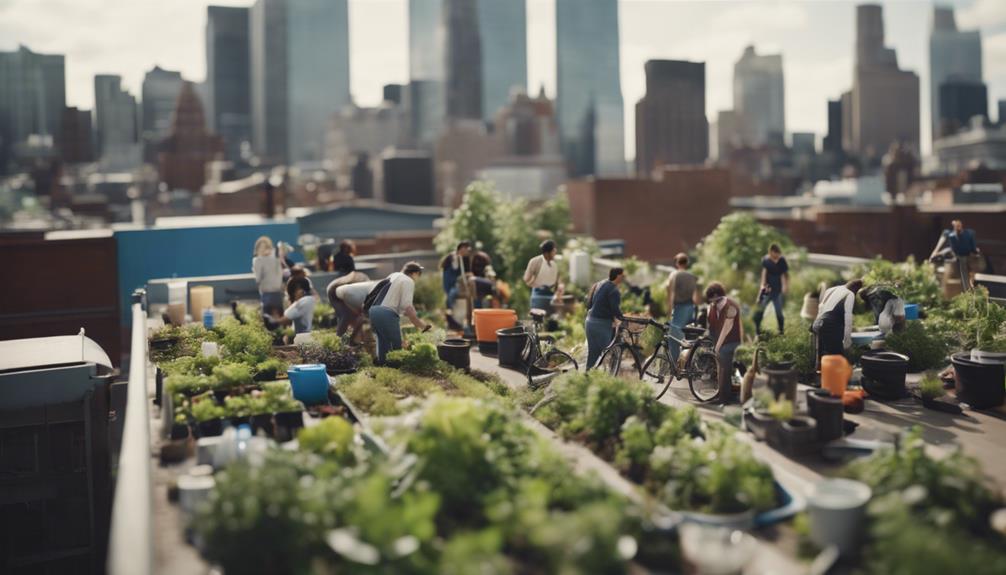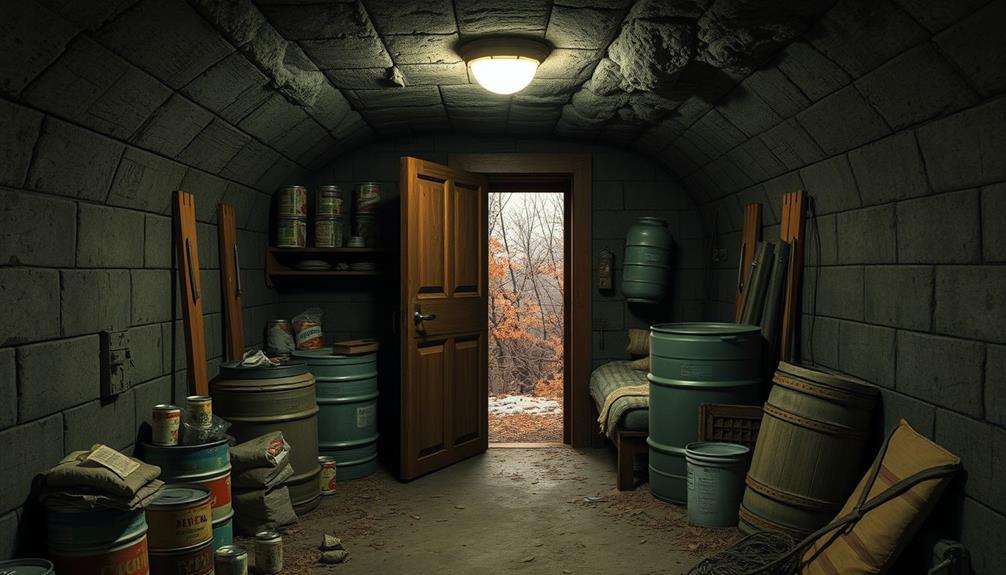Prepare for urban challenges by customizing your bug out kit with city-specific gear like navigation tools and self-defense items. Create multiple evacuation routes, identify safe shelter locations, and establish a communication plan with neighbors. Be ready for water and electricity outages by storing water, investing in purification, and planning for long-term needs. Consider building a home safe room following FEMA guidelines and investing in a power backup system. These strategies will help you stay prepared in urban environments and face any crisis with confidence.
Key Takeaways
- Prioritize lightweight essentials for easy mobility.
- Include urban-specific gear like self-defense tools.
- Plan multiple evacuation routes for diverse scenarios.
- Establish communication plans with neighbors or groups.
- Utilize compact storage solutions for limited urban space.
Understanding Urban Survival Challenges
Moving through crowded streets and limited spaces presents significant challenges for urban survival preparedness. In urban environments, where resources may be scarce during emergencies, the need to adapt quickly is essential.
Limited space for storage and evacuation planning further complicates preparedness efforts. Safety concerns, including high crime rates, add an additional layer of complexity to urban survival strategies.
Additionally, urban areas are susceptible to infrastructure vulnerabilities such as power outages and transportation disruptions, which can severely impact one's ability to navigate and respond effectively in emergencies.
Ensuring you have a well-thought-out emergency plan tailored to urban settings is paramount. Consider the constraints of limited space when stockpiling essential resources like food and water.
Be vigilant about safety, especially in high-risk areas, and develop strategies to mitigate potential risks. Understanding the unique challenges of urban environments will better equip you to navigate emergencies and safeguard yourself and your loved ones.
Tailoring Bug Out Kits for Cities

When preparing your bug out kit for city scenarios, remember to choose gear tailored to urban challenges. Opt for compact storage solutions and prioritize navigation tools for city environments.
Urban-specific items like city maps, public transportation schedules, and self-defense tools can enhance your preparedness in an urban bug out situation.
Stay equipped with lightweight essentials like energy bars, water purification tablets, and communication devices for emergencies in the city.
Urban-Specific Gear Choices
Wondering how to tailor your bug out kit for city environments? When preparing for urban scenarios, it's vital to select compact gear options that are easy to carry through crowded streets.
Urban-specific items like a tactical pen, emergency whistle, and city map are essential additions to your bug out gear. Opt for versatile gear such as a multi-tool, portable phone charger, and reflective gear to guarantee urban safety and preparedness in diverse situations.
Prioritize self-defense tools like a Kubaton or pepper spray to protect yourself in urban bug out scenarios where personal safety is a concern. Additionally, include urban-specific communication devices like a handheld radio or emergency beacon to stay connected and signal for help if needed.
Compact Storage Solutions
Opt for space-saving storage solutions to streamline your urban bug out kit, ensuring essential supplies are compactly organized for easy access in city environments.
In urban settings, where space is a premium, maximizing the efficiency of your emergency preparedness gear is vital. Consider utilizing multifunctional furniture that doubles as storage to optimize your living space for emergency supplies.
Tailor your bug out kits for cities by including compact tools, first-aid supplies, and emergency food rations that can easily fit into small storage spaces.
Vacuum-sealing clothing and snacks can greatly reduce the bulk of your supplies, allowing for more efficient storage in tight quarters.
Additionally, portable water purification systems are essential for treating water in small living spaces during emergencies, ensuring you have access to clean drinking water.
Plan for compact and efficient storage solutions to guarantee easy access and mobility of your emergency supplies in urban environments.
Navigation in Cities
Consider incorporating urban-specific orientation tools and strategies into your bug out kit to effectively maneuver through city environments during emergencies. Urban orientation entails mapping out city streets, public transportation routes, and alternative paths for evacuation. Tailoring your bug out kit for cities should include compact, lightweight gear suitable for urban environments. Be prepared for urban-specific challenges like traffic congestion, road closures, and limited escape routes by equipping yourself with GPS devices, maps, and knowledge of urban landmarks. Moving through crowded areas and high-rise buildings requires special attention in urban bug out plans, accounting for potential hazards unique to cities.
| Urban Orientation Tools | Benefits |
|---|---|
| GPS Devices | Provide accurate location tracking |
| City Maps | Help in planning alternative routes |
| Compass | Aid in orientation in unfamiliar areas |
| Knowledge of Landmarks | Assist in orientation without technology |
| Emergency Whistle | Signal for help in dense urban areas |
Evacuation Strategies for Urban Dwellers

Urban dwellers must carefully plan multiple evacuation routes to account for potential hazards and traffic congestion. Identify safe locations within the city or nearby where you can seek shelter during emergencies. Coordinate with neighbors or community groups for mutual aid and support during evacuations. Stay informed about local emergency protocols and evacuation procedures specific to urban areas. In case of road blockages, consider alternative modes of transportation such as bikes or walking to navigate through the city efficiently.
When planning your evacuation routes, make sure you have several options in different directions to avoid getting stuck in traffic or facing road blockages. Knowing safe locations within the city where you can find shelter is essential for your evacuation plan. Additionally, establishing a network of mutual aid with neighbors or community groups can provide valuable support during emergencies. Stay updated on local emergency protocols to respond effectively to evacuation orders and follow designated procedures.
Consider alternative transportation methods to navigate urban environments in case traditional routes are inaccessible. By preparing ahead and considering these factors, you can enhance your readiness for potential evacuations in urban areas.
Securing Your City Home

Enhance the security of your city home by installing security cameras, alarms, and reinforced doors and windows. These measures help fortify your home against potential intruders and promote a safer living environment. Consider joining a neighborhood watch program or community security group to increase vigilance and protection in your area.
In addition to security measures, it's important to keep emergency supplies like first aid kits, flashlights, and non-perishable food stocked in your city home. These supplies can be essential during disasters or emergencies. Plan and practice fire escape routes within your home to guarantee a safe evacuation in case of a fire emergency.
Regularly inspecting and maintaining your city home's structural integrity is also essential. This practice helps prevent damage during natural disasters such as earthquakes. By taking these steps, you can greatly improve the security and safety of your city home.
Stocking Essential Food and Supplies

When preparing for urban survival, make sure you stock essential food and supplies to sustain yourself during emergencies.
In urban areas, where space is limited, opt for high-calorie, non-perishable foods like dried meat and peanut butter for efficient food storage. Choose space-efficient dry goods over bulky canned items to make the most of your city home's storage capabilities.
Remember to rotate your food stock regularly, consuming items nearing expiration dates to keep everything fresh. Additionally, consider vacuum-sealing clothing and snacks for compactness when assembling your city bug-out bag.
For portable water solutions, invest in purifying water filters and containers that are suitable for efficient water storage in urban environments. Being prepared with well-stocked essential food and water supplies can make a significant difference in how you handle an emergency situation in the city.
Establishing Communication Plans

To guarantee effective coordination and timely communication during emergencies in urban environments, it's imperative to establish detailed communication plans with your family, neighbors, and community members.
Here are some key steps to certify your communication plan is robust and efficient:
- Create a Communication Tree: Outline a list of contacts and communication methods for each person in your network to follow in case of disruptions.
- Utilize Multiple Communication Channels: Use a variety of communication tools such as text messages, phone calls, social media, and walkie-talkies to guarantee redundancy in reaching out to others.
- Designate a Meeting Point: Establish a specific location where you and your loved ones can reunite if separated during a crisis, ensuring everyone knows where to go.
- Practice Communication Drills: Conduct regular drills to familiarize everyone with the plan, test different communication methods, and enhance the efficiency of reaching each other swiftly.
Managing Water and Electricity Outages

When preparing for potential water outages, remember to store bottled water in accessible areas and fill tubs and sinks as backup sources.
For electricity outages, consider investing in generators or solar chargers for power backup solutions.
These simple steps can help you stay prepared and resilient during unexpected outages in urban environments.
Water Storage Tips
For managing water and electricity outages, consider implementing these water storage tips.
- Store Bottled Water: Keep bottled water in closets or pantries for easy access during water outages.
- Invest in Water Purification: Purchase water purification filters and containers to secure additional supply during outages.
- Fill Tubs and Sinks: Before an outage, fill tubs and sinks with water to create a reserve for essential needs.
- Plan for Long-Term Storage: Utilize a water purification system to prepare for extended water outages.
In an urban environment, having a reliable water supply is important for emergency response and staying prepared. With the potential for electricity outages to disrupt water access, it's crucial to have alternative water sources available. By following these water storage tips, you can make sure that you have enough water to sustain yourself and your family during any water or electricity outages that may occur.
Power Backup Solutions
Invest in a backup power generator to guarantee uninterrupted electricity supply during outages, enhancing your preparedness for managing water and electricity disruptions in urban environments. When faced with power outages, having a backup power generator can be a lifesaver, ensuring that essential appliances keep running.
Additionally, consider utilizing solar panels or portable battery packs to recharge devices and maintain basic functions during extended power outages. Emergency lighting solutions such as flashlights and lanterns are important for moving around in the dark when the power is out.
To complement your power backup solutions, installing a rainwater harvesting system can provide a reliable water source during emergencies in urban settings. Storing extra water in containers and employing water purification methods will help you cope with prolonged water outages.
Building a Home Safe Room

Consider creating a secure space within your home by constructing a dedicated safe room. In the case of urban living, having a safe room is important for staying prepared for potential disasters or security threats.
Here's how you can plan and build your home safe room:
- Assess Your Needs: Determine the purpose of your safe room – whether it's for protection during natural disasters like hurricanes or as a secure space in case of home invasions.
- Follow FEMA Guidelines: Guarantee your safe room meets FEMA specifications to secure structural integrity and safety for you and your family.
- Enhance Security: Explore advanced security measures such as condos in fortified complexes or luxury bunker complexes for additional protection beyond a basic safe room.
- Consider Location: When planning your safe room, think about the most strategic location within your home for quick access and maximum security.
Frequently Asked Questions
How to Prep if You Live in a City?
To prep if you live in a city, prioritize a compact bug-out bag with essentials like a multi-tool, cash, and documents. Maximize urban living space for storage. Create evacuation plans with city-specific considerations. Stay informed about local resources and adapt strategies for urban challenges.
How to Survive in Urban Areas?
To survive in urban areas, prioritize essential skills like first aid, navigation, and communication. Utilize resources such as emergency alert apps and community networks for support. Stay informed about local news, emergency protocols, and threats specific to urban environments.
How to Be a Prepper in the Suburbs?
To be a prepper in the suburbs, focus on fortifying your home and building community connections. Stock up on suburban-specific supplies, such as gardening tools. Prepare for threats like power outages and enhance security measures for your neighborhood.
Can Urban Prepping Techniques also be Applied to Hurricane Preparedness?
Urban prepping techniques can definitely be applied to hurricane preparedness. In fact, many essential hurricane preparedness tips, such as stockpiling non-perishable food and water, creating emergency communication plans, and securing your home, align with urban prepping strategies. It’s all about being ready for any potential disaster.
Conclusion
So, city preppers, remember to stay vigilant and prepared for any urban survival challenges that may come your way.
Did you know that 80% of natural disasters in the United States occur in urban areas?
By tailoring your bug out kits, securing your home, and stocking essential supplies, you can guarantee you're ready for whatever may come your way in the city.
Stay safe and stay prepared!










